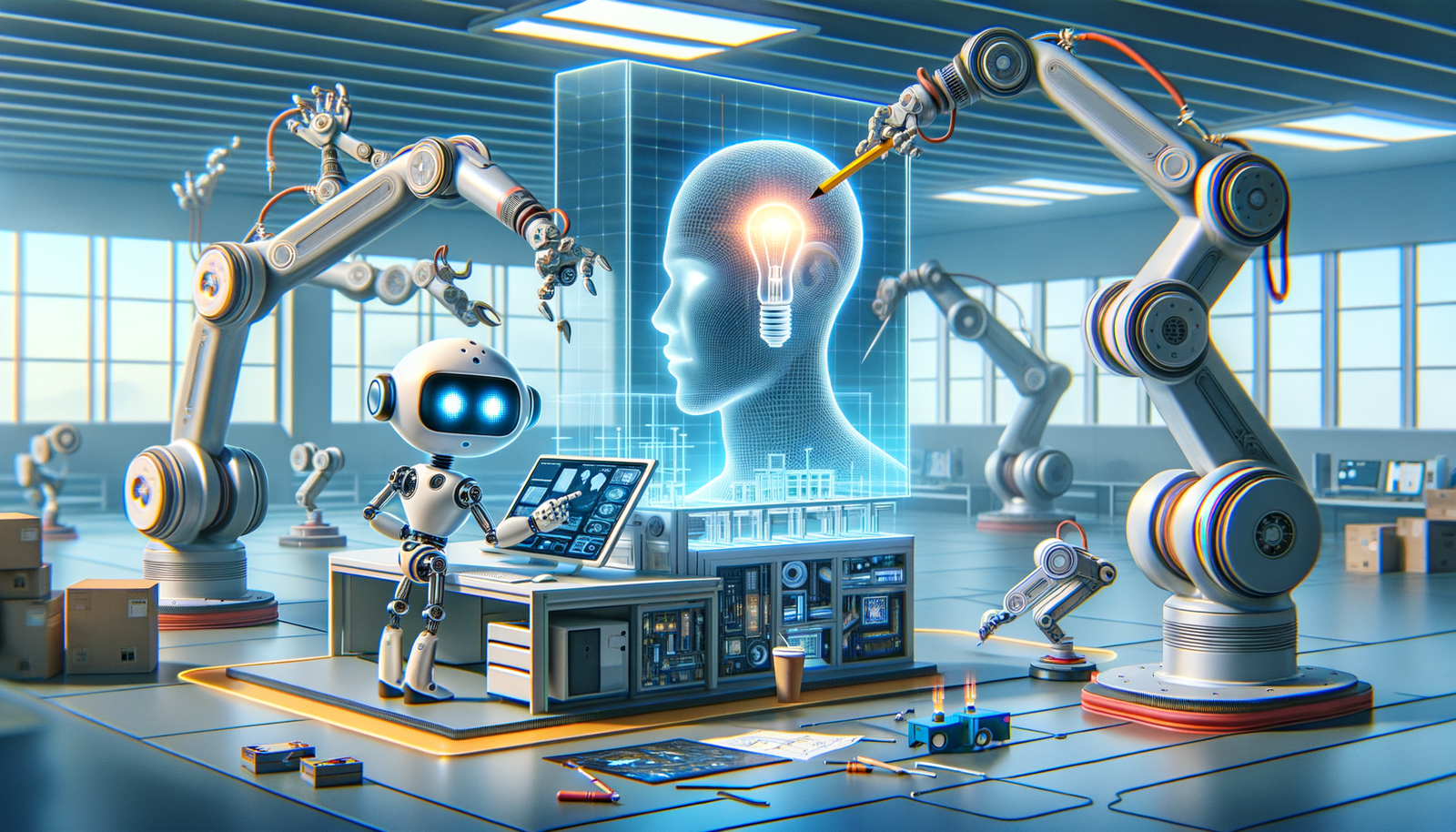Your Cart is Empty
Customer Testimonials
-
"Great customer service. The folks at Novedge were super helpful in navigating a somewhat complicated order including software upgrades and serial numbers in various stages of inactivity. They were friendly and helpful throughout the process.."
Ruben Ruckmark
"Quick & very helpful. We have been using Novedge for years and are very happy with their quick service when we need to make a purchase and excellent support resolving any issues."
Will Woodson
"Scott is the best. He reminds me about subscriptions dates, guides me in the correct direction for updates. He always responds promptly to me. He is literally the reason I continue to work with Novedge and will do so in the future."
Edward Mchugh
"Calvin Lok is “the man”. After my purchase of Sketchup 2021, he called me and provided step-by-step instructions to ease me through difficulties I was having with the setup of my new software."
Mike Borzage
Harnessing AI and Automation for Next-Gen Design Excellence
February 24, 2025 9 min read


Overview of Design Automation
Design automation has fundamentally transformed how modern design workflows operate. By automating repetitive and time-consuming tasks, designers can focus more on creativity and innovation rather than getting bogged down in the minutiae of manual processes. Traditionally, design processes were heavily reliant on manual drafting, calculations, and iterations, which often led to increased time consumption and a higher potential for human error. In contrast, automated design processes leverage technology to enhance efficiency, accuracy, and consistency across projects. The significance of design automation lies in its ability to streamline workflows, reduce costs, and accelerate project timelines. As the complexity of design projects grows, the need for efficient and reliable automation solutions becomes increasingly critical. The integration of automation tools enables designers to rapidly prototype ideas, test various scenarios, and optimize designs without the painstaking manual effort that was once required.
The Rise of Artificial Intelligence in Design
The incorporation of artificial intelligence into design practices marks a significant evolution in the field of design software. Historically, design tools provided static functions that required extensive input and guidance from the user. However, the advent of AI has introduced dynamic capabilities that enable software to learn from data, recognize patterns, and even predict outcomes. This shift began with the development of basic machine learning algorithms that could perform tasks such as image recognition and data analysis. Over time, as computational power increased and data became more abundant, AI technologies matured and found their way into design applications. Key drivers behind this integration include the desire for greater efficiency, the need to process and interpret vast amounts of data, and the push towards more innovative and optimized design solutions. AI empowers designers to explore complex design spaces that would be impractical to navigate manually, leading to more informed decision-making and groundbreaking innovations.
Current Landscape of AI-Enhanced Design Tools
The current market is witnessing a proliferation of AI-powered design software that is reshaping how projects are conceptualized and executed. These tools leverage advanced algorithms to enhance various aspects of the design process, from ideation to execution. Popular software solutions integrate features such as generative design, predictive analytics, and real-time feedback to assist designers in creating more sophisticated and efficient designs. For example, some CAD platforms now include AI modules that can suggest design modifications based on performance criteria or manufacturing constraints. These AI enhancements allow for on-the-fly adjustments and optimizations that were previously unattainable. By incorporating machine learning and other AI technologies, design software is becoming more interactive and responsive to the needs of the designer, ultimately leading to better outcomes and a more streamlined workflow.
Machine Learning Algorithms
Machine learning algorithms play a pivotal role in predictive design and pattern recognition within design automation. They enable software to learn from historical data and identify trends that can inform future design decisions. By analyzing large datasets, machine learning models can predict how certain design choices might impact performance, cost, or manufacturability. This predictive capability is invaluable for designers seeking to optimize their work without the need for extensive trial and error. Examples of machine learning applications in design automation include optimizing material selections based on usage patterns, predicting stress points in structural elements, and customizing user experiences within software interfaces. With machine learning, the design process becomes more data-driven, allowing for informed decisions that enhance the quality and efficiency of the final product.
Generative Design Techniques
Generative design is a revolutionary approach that utilizes algorithms to automatically create design alternatives based on specified constraints and objectives. By inputting parameters such as material properties, manufacturing methods, and performance criteria, designers can generate a vast array of design options that meet the defined requirements. The principles of generative design revolve around leveraging computational power to explore design spaces that are too complex for manual exploration. This technique benefits innovation by uncovering unconventional solutions that might not have been considered otherwise. Additionally, generative design can significantly improve efficiency in product development by reducing the time required to identify optimal designs. Designers can rapidly iterate through potential configurations, refining them based on real-time feedback and analysis.
- Exploration of multiple design alternatives simultaneously
- Optimization based on specific performance criteria
- Reduction of material usage and cost through efficient design
Natural Language Processing (NLP)
Natural Language Processing (NLP) enhances user interaction with design software by enabling voice commands and text inputs. This technology allows designers to communicate with software in a more intuitive and natural manner. By leveraging NLP, design tools can interpret and execute commands given in plain language, streamlining the workflow and reducing the learning curve associated with complex software interfaces. For instance, a designer might simply describe a desired adjustment or feature, and the software can interpret the request and implement it accordingly. NLP also facilitates better collaboration by allowing for easy integration of feedback and modifications. Designers can input comments or directives, and the software can parse these inputs to make appropriate changes, thereby streamlining design modifications and feedback loops.
Computer Vision and Image Recognition
Computer vision and image recognition technologies facilitate advanced visualization and quality assurance in design software. By processing visual data, these technologies enable software to understand and interpret images, diagrams, and 3D models. Integration with CAD and other design platforms allows for features such as automated error detection, real-time visualization of design changes, and enhanced rendering capabilities. For example, computer vision can be used to identify inconsistencies or potential issues within a design, such as overlapping components or structural weaknesses. This proactive approach to quality assurance helps prevent costly errors and ensures that designs meet the necessary specifications before moving into production. Additionally, image recognition can enhance the user experience by allowing designers to manipulate models using gestures or by recognizing hand-drawn sketches and converting them into precise digital models.
Increased Efficiency and Productivity
One of the most significant benefits of AI-driven design automation is the marked increase in efficiency and productivity. Automation of repetitive tasks frees designers from mundane activities, allowing them to dedicate more time to creative problem-solving. By reducing manual errors and standardizing processes, AI helps ensure consistency and accuracy across projects. Faster iteration cycles are achieved through real-time feedback and optimization tools, which accelerate project timelines. Designers can quickly test various scenarios, receive immediate insights, and implement changes without the delays associated with traditional methods. This acceleration not only enhances productivity but also improves the overall quality of the design, as more time can be spent refining and perfecting the final product.
- Automation reduces manual workload
- Real-time feedback enables quick adjustments
- Standardization improves consistency across designs
Enhanced Creativity and Innovation
AI-driven tools expand design possibilities by providing AI-generated suggestions and insights that might not be immediately apparent to human designers. By analyzing vast amounts of data and exploring numerous design permutations, AI can propose unconventional solutions that challenge traditional thinking. This capability enables designers to explore new concepts and methodologies, fostering innovation and pushing the boundaries of what is possible. Designers are empowered to consider a broader range of options, including those that optimize performance or efficiency in ways that might have been overlooked. The partnership between human creativity and AI's computational power leads to more innovative and effective design outcomes.
Improved Decision-Making and Optimization
AI provides data-driven insights that enhance decision-making in the design process. By utilizing algorithms that analyze performance metrics, material properties, and cost considerations, designers can make more informed choices. AI tools can optimize designs for specific objectives, such as minimizing material usage while maintaining structural integrity or adjusting shapes to improve aerodynamics. This optimization reduces waste and can lead to significant cost savings. Additionally, AI helps in balancing multiple competing factors, allowing designers to achieve the best possible outcome within the given constraints. The ability to quickly simulate and assess different design scenarios facilitates a more strategic approach to product development.
Industry-Specific Applications
AI-driven design automation has diverse applications across various industries, including architecture, automotive, product design, and more. In architecture, AI tools assist in generating optimized building layouts that maximize space utilization and energy efficiency. In the automotive industry, AI aids in designing vehicles with improved performance and safety features. In product design, AI helps create products that meet specific user needs and preferences by analyzing consumer data and trends. The impact of AI-driven projects is significant, as it leads to more innovative products, faster development cycles, and enhanced competitiveness in the market. By tailoring AI applications to industry-specific challenges, organizations can leverage these technologies to achieve better outcomes and drive growth.
Technical and Implementation Challenges
Despite the numerous benefits, integrating AI into existing design workflows and software presents technical and implementation challenges. Compatibility issues can arise when attempting to incorporate AI tools with legacy systems or when transitioning from traditional processes. Ensuring data accuracy is critical, as AI algorithms rely heavily on the quality of input data. Managing large datasets can be resource-intensive, requiring robust IT infrastructure and data management strategies. Additionally, the complexity of AI technologies may necessitate specialized knowledge and skills to effectively implement and maintain these systems. Organizations must carefully plan and execute their AI integration efforts to minimize disruptions and achieve the desired benefits.
Ethical Considerations and AI Bias
Addressing biases in AI algorithms is essential to ensure fairness and ethical integrity in automated design decisions. AI systems can inadvertently perpetuate biases present in the data they are trained on, leading to skewed or discriminatory outcomes. This is particularly concerning when AI-driven designs impact user safety, accessibility, or equity. Ethical implications also arise from the potential over-reliance on automated decision-making, which might sideline human judgment and intuition. Designers and organizations must proactively work to identify and mitigate biases, implementing checks and balances within AI systems. Establishing ethical guidelines and transparency in AI processes is crucial to maintain trust and integrity in design automation.
Skill Requirements and Workforce Adaptation
The rise of AI in design necessitates training designers to work alongside AI tools. This evolution requires the development of new skills, such as data analysis, AI system interaction, and understanding of algorithmic processes. Workforce adaptation involves rethinking traditional roles and responsibilities, as some tasks become automated while new functions emerge. Designers must embrace a mindset of continuous learning to effectively leverage AI technologies. Organizations may need to invest in training programs and resources to support this transition. By equipping designers with the necessary skills, the integration of AI can enhance rather than disrupt the creative process.
Future Directions and Innovations
Emerging AI technologies are poised to further transform design automation in the coming years. Advances in areas such as deep learning, reinforcement learning, and quantum computing hold the potential to unlock even more sophisticated design capabilities. For instance, the use of AI in simulating complex systems could lead to more accurate predictions and optimized solutions. Predictions for the next decade include increased personalization of design tools, greater integration of virtual and augmented reality, and the expansion of AI into all aspects of the design process. Staying abreast of these innovations will be essential for designers and organizations seeking to maintain a competitive edge.
Recap of AI’s Impact on Design Automation
The integration of artificial intelligence into design automation has introduced significant benefits and advancements. AI enhances efficiency and productivity by automating tasks and reducing errors. It fosters creativity and innovation by expanding design possibilities and providing intelligent suggestions. Decision-making is improved through data-driven insights and optimization tools. Across various industries, AI-driven design has led to better products, faster development times, and increased competitiveness. The transformative impact of AI cannot be overstated, as it continues to reshape the landscape of design software and workflows.
Balancing Automation with Human Creativity
While AI offers powerful tools and capabilities, maintaining the designer’s vision and intuition remains paramount. Balancing automation with human creativity ensures that designs are not only technically sound but also resonate on a human level. Designers must leverage AI as an aid rather than a replacement, using technology to enhance their creative expression. By combining the strengths of AI with human insight, the design process becomes more holistic and effective. It is crucial to recognize the value of human judgment, particularly in areas where emotional intelligence and aesthetic sensibilities play a significant role.
Looking Ahead: Embracing AI for Future Design Excellence
Embracing AI tools requires a commitment to continuous learning and adaptation. Designers and organizations must stay informed about the latest developments and be willing to integrate new technologies into their workflows. This proactive approach will enable them to fully leverage the benefits of AI and achieve excellence in their designs. Collaboration between technologists and designers is essential to develop tools that meet practical needs while pushing the boundaries of what is possible. By fostering an environment of innovation and adaptability, the design community can harness AI to drive future success.
Final Thoughts
The transformative potential of AI in shaping the future of design software is immense. As technology continues to evolve, the possibilities for innovation and improvement expand exponentially. By thoughtfully integrating AI into design processes, embracing new tools, and maintaining a focus on human creativity, the future of design holds exciting opportunities. The journey towards AI-enhanced design is an ongoing one, and those who engage with it fully are poised to lead the way in crafting groundbreaking solutions and setting new standards of excellence in the field.
Also in Design News

ZBrush Tip: Maximizing Abstract Visualization with ZBrush Sculptris Pro Mode Techniques
February 25, 2025 2 min read
Read More
Revit Tip: Enhancing Workflow with Revit's Temporary Hide/Isolate Tool
February 25, 2025 2 min read
Read More
AutoCAD Tip: Optimizing AutoCAD Efficiency with Custom Quick Access Toolbar Configuration
February 25, 2025 2 min read
Read MoreSubscribe
Sign up to get the latest on sales, new releases and more …


